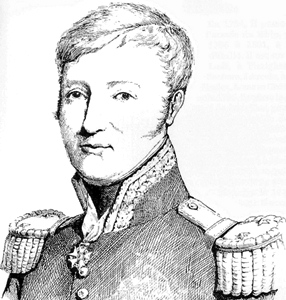General Vital Joachim Chamorin

Born: August 16, 1773
Place of Birth: Bonnelles, Yvelines, France
Died: March 25, 1811
Cause of Death: Killed in action
Place of Death: Campo Maior, Portugal
Arc de Triomphe: CHAMORIN on the south pillar
Pronunciation:
Vital Joachim Chamorin began his military career by enlisting in the regiment of Champagne in 1788. Once the French Revolution was underway, in 1792 he served with the Army of the South and he served at the action of Nice. In 1793 Chamorin joined the Army of Italy and he fought at Sospello, and then in July he joined the 6th Battalion of Volunteers of Hérault. He went on to serve with the Army of the Eastern Pyrenees, serving at the siege of Campredon before being promoted to sous-lieutenant in October. The next year Chamorin fought at the camp of Boulou where he was wounded in the left leg by grapeshot, but he also received a promotion to capitaine on the field of battle.
Captain Chamorin next transferred to the Army of the Rhine, where he would spend the next few years. In March of 1796 he served in Haute-Loire against some rebels, and then in the latter half of the year he joined the Army of Italy, notably fighting at Arcola in November. In 1798 Chamorin served with the Army of Rome, participating in the combats at Frosinone and Chateau Saint-Elme at Naples.
In March of 1800 Chamorin became an aide-de-camp to General Sauret, but two months later he joined the newly formed Army of the Reserve as an aide-de-camp to General Watrin. With General Watrin, he served at Ivrée in May and then in June he served at the Battle of Montebello where he was wounded by a shot to the right hip. Despite this injury, Chamorin went on to fight a few days later at Marengo. On Christmas Day of that year he fought at Pozzolo where he was again wounded, this time by a shot to the right side. Chamorin was once again rewarded on the field of battle, this time being promoted to chef d'escadron.
In 1801 Chamorin followed General Watrin to the isle of Elba, where he took part in successfully repulsing two attempted landings by the British, the first in May and the second in September. Next Watrin was sent to Saint-Domingue so Chamorin went with him to Saint-Domingue, but after Watrin's death from illness in November of 1802 Chamorin returned to France.
Back in France, Chamorin was placed with the 3rd Cuirassiers. When war broke out in 1805, Chamorin was transferred to the Grenadiers à Cheval of the Imperial Guard as a chef d'escadron. Over the following years, he fought at Austerlitz, Jena, Hoff, and Eylau. Shortly after Eylau he left the Imperial Guard to become the colonel of the 26th Dragoons, serving first under Klein and then under Latour-Maubourg. In June he fought at Heilsberg where he was wounded by a shot to the right leg, but like earlier in his career he continued on and a few days later he fought at the Battle of Friedland.
In November of 1808 Colonel Chamorin and his unit entered Spain, serving at Burgos, Calahorra, and Tudela that month. The next month he was named a Commander of the Legion of Honor. In January of 1809 Chamorin fought at Uclès and Trixillo, and then the following month he was made a Baron of the Empire. Continuing to fight, that March he fought at Medellin , then in July he fought at Talavera , and finally in November he fought at Ocaña . In 1810 Chamorin won the battle at Ignojoza in April and then in December he won at Azuaga.
1811 started busy for Colonel Chamorin. He took part in the sieges of Olivenza and Badajoz before fighting at the Battle of Gebora in February. On March 5th he received a promotion to général de brigade for his services, but he was not to enjoy this rank for long. Later that month he was leading his men into battle at Campo Maior when he was killed by two saber blows from enemy cavalry.
Bibliography
- Divry, Arnauld. Les Noms Gravés sur l'Arc de Triomphe. Paris: L'Harmattan, 2017.
- Six, Georges. Dictionnaire Biographique des Généraux & Amiraux Français de la Révolution et de l'Empire (1792-1814). 2 vols. Paris: Gaston Saffroy, 2003.
Updated June 2024
© Nathan D. Jensen